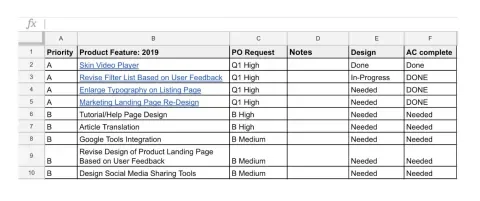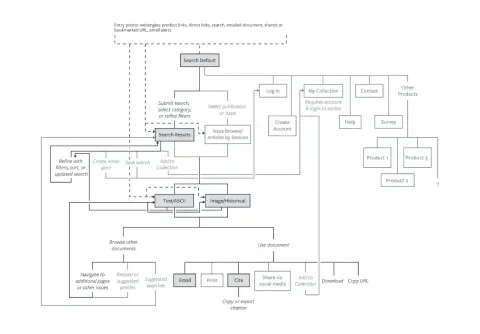It's never too late to start thinking about user experience design when working on a project. To help ensure the project is a success, it's best to have a UX designer involved in the project as early as possible. However, circumstances may not always be ideal, and User Experience may become an afterthought. Sometimes it isn't until the project is already well on its way when questions around user experience start popping up, and a decision is made to bring in a professional to help craft the necessary solutions.
What’s the best way for a UX designer to join a project that is well on its way? In this article, we will discuss some actions that UX designers can take to help create a smooth process when joining a project already in progress.
General Onboarding
Planning and implementing an onboarding process can help set the tone for the remainder of the project. If it’s disorganized and not well planned out, you can feel underprepared for the first task, which can lead to a longer design process.
It’s helpful to designate a project team member to help with on-boarding. It should be someone who knows the project well and can help answer questions about the project and process. This is usually a product owner or a project manager but isn’t limited to either. If you haven’t been assigned someone to help you with the on-boarding process, reach out to help identify which team member would be best for this role.
During the on-boarding process, discuss what user experience issues the team is hoping to solve, and also review the background of significant decisions that were made. This will help you to evaluate the current state of the project as well as the history of the decision-making process. You should also make sure you understand the project goals and the intended audience. Ask for any documentation around usability testing, acceptance criteria, competitive reviews, or notes for meetings that discuss essential features. Don’t be afraid ask questions to help you fully grasp the project itself. And don’t forget to ask why. Sometimes entertaining the mindset of a five-year-old when trying to understand will help you find the answers you’re seeking.
Process Evaluation
How you climb a mountain is more important than reaching the top.
- Yvon Chouinard
Processes help ensure that the project goes smoothly, is on time, and on budget. They can also be a checkpoint for all those involved. If a process doesn't already exist that includes UX Design, work together with the team to establish a process to discuss, track and review work. If you feel that a process step is missing or a current system isn't working, speak up and work with the team to revise it. Make sure to include any critical process that the team may be lacking. You also may want to make sure that discussions around any important features include a UX Designer. Ask if there are any product meetings that you should be joining to help give input as early as possible.
Schedule Weekly Design Reviews
One example of improving the process to include UX Design is scheduling weekly meetings to review design work that’s in progress. This also gives project members an opportunity to ask questions and discuss upcoming features and acceptance criteria.
Incorporate Usability Testing
Another suggestion is to include usability tests on a few completed important features before moving ahead. The results of the usability tests may help give direction or answer questions the product team has been struggling with. It can also help prioritize upcoming features or feature changes. The most important thing to remember is that usability testing can help improve the product, so it’s tailored to your specific users, and this should be communicated to the project team.
Collect General User Feedback
Establishing early on the best way to collect and give feedback on a design or feature can help streamline the design process. Should it be written feedback? Or would a meeting work better where everyone can speak up? Sometimes, when multiple people are reviewing and giving feedback, it’s best to appoint one person to collect and aggregate the input before it filters down to you.
Track Project Progress
You also want to discuss the best way to track work in progress. If your team is using an agile process, one idea is to include design tickets in the same software that you’re using to keep track of sprints such as Jira or Trello. Discuss the best way for summarizing features, adding acceptance criteria and tracking input in whatever system you decide to use.
Prioritization of Work
Efficiency is doing things right; effectiveness is doing the right things.
- Peter Drucker
The team should be clear on priorities when it comes to work, features, and feedback. Joining a team that’s in progress can be very overwhelming to both the designers and stakeholders and creating clear priorities can help set expectations and make it clear to both sides on what the team should focus on first.
If a list of priorities doesn't already exist, create one. It doesn't have to be fancy. A simple excel sheet or Google Sheets will do. You can create separate priority lists for things like upcoming features that need design, QA, or user feedback. You can also combine everything into a single list if that works better for your team. Just make sure that it links to or includes as much detail as possible. In the example below, a feature that has completed acceptance criteria is linked to a ticket in Jira that explains all of the details.
It’s also helpful to group related features together, even though they may have different priorities. This will help you think about how to approach a feature without needing to reworking it later down the line.
Be proactive. Ask questions around the priority of items if something doesn't make sense to you. If needed, volunteer to help prioritize features based on what makes sense for a holistic finished product or feature. Creating diagrams and flowcharts can help get everyone to understand how separate features can be connected and what makes the most sense to tackle first. Make sure that QA and user feedback is also part of the priority process.
Summary
Having any team member join a project mid-process can be intimidating for all parties involved, but it’s important to be open and understanding. Improving the process and the end result is in everyone's interest, and giving and accepting feedback with an open mind can play an important role in ensuring that the project runs smoothly for everyone involved.
For User Experience Designers, it’s important to respect what’s already been accomplished and established with the idea that you should tread lightly to make small improvements at first. This will help gain confidence from the team, while also giving you time to learn about the project and understand the decisions that lead up to where it’s at today. For stakeholders involved, it’s important to listen with an open mind and take a small step back to reevaluate the best way to include UX in the process moving forward. The above suggestions can help both parties understand what actions they can take to help make the onboarding process for a UX Designer a smooth transition.


